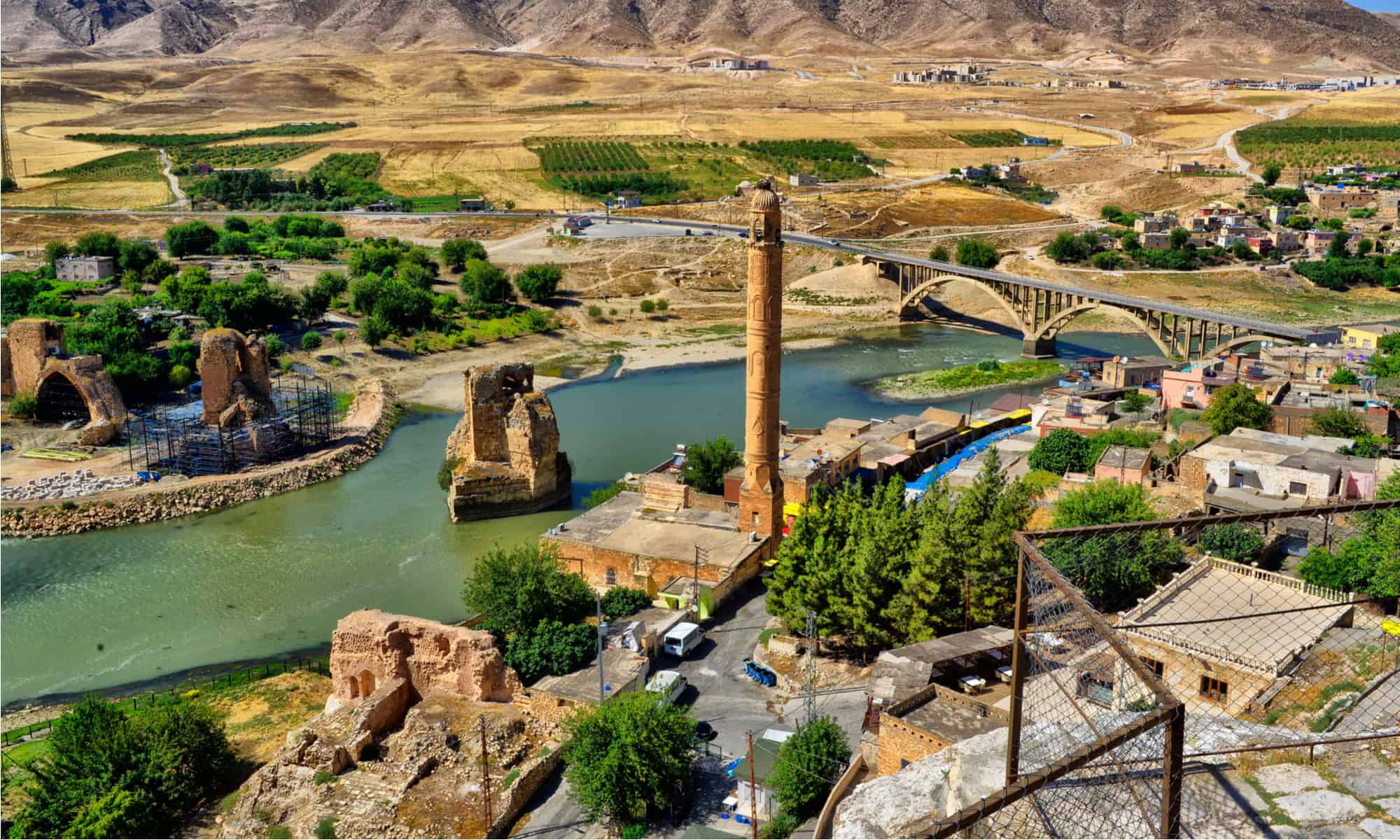Home>Gardening Tips and Tricks>Problem Solving>What Was The Function Of The Tigris River In Mesopotamian Irrigation?


Problem Solving
What Was The Function Of The Tigris River In Mesopotamian Irrigation?
Modified: February 5, 2024
Learn about the crucial role of the Tigris River in ancient Mesopotamian irrigation systems and its significance in problem-solving for agricultural challenges.
(Many of the links in this article redirect to a specific reviewed product. Your purchase of these products through affiliate links helps to generate commission for Chicagolandgardening.com, at no extra cost. Learn more)
Table of Contents
Introduction
Welcome to the fascinating world of Mesopotamian irrigation, where the Tigris River played a vital role in sustaining one of the most advanced civilizations in ancient history. Located in the fertile lands of modern-day Iraq, the Tigris River was a lifeline for the Mesopotamians, providing water for agriculture, transportation, and trade.
Mesopotamia, often referred to as the “cradle of civilization,” was home to various city-states, including Sumer, Babylon, and Assyria, during different time periods. These societies flourished, thanks in large part to their mastery of irrigation techniques. Irrigation was essential for mitigating the region’s arid climate and transforming the land into a productive agricultural paradise.
In this article, we will explore the function of the Tigris River in Mesopotamian irrigation. We will delve into the historical context, understand the overview of the river, and examine its role in supporting agriculture. Additionally, we will explore the management and control of the river and discuss the impact it had on agricultural productivity. Lastly, we will highlight the challenges and limitations faced by the Mesopotamians in utilizing the Tigris River for irrigation.
Join us on this journey as we unravel the secrets and marvel at the engineering feats of an ancient civilization that harnessed the power of the Tigris River to create a prosperous and enduring society.
Historical Context of Mesopotamian Irrigation
The history of irrigation in Mesopotamia dates back to the 4th millennium BCE, during the rise of the Sumerian city-states. The region’s geographical location between the Tigris and Euphrates Rivers provided the perfect setting for agricultural development. However, the unpredictable nature of these rivers necessitated the construction of irrigation systems to ensure a consistent water supply for farming.
The early Mesopotamians were ingenious in their approach to irrigation. They recognized the need to control and divert water from the rivers to their fields, thereby maximizing agricultural output. Irrigation canals, embankments, and reservoirs were constructed to capture and distribute water throughout the fertile plains of Mesopotamia. These early irrigation systems laid the foundation for the remarkable advancements in water management that would follow in subsequent centuries.
Over time, Mesopotamia saw the rise and fall of numerous empires, including the Akkadians, Babylonians, and Assyrians. Each civilization contributed to the development of irrigation techniques, with improvements made to existing infrastructure and the construction of new canals and reservoirs.
One of the most significant developments in Mesopotamian irrigation came with the advent of the qanat system. This underground irrigation infrastructure allowed for the extraction of groundwater, reducing dependence on the unpredictable river flows. The qanat system played a crucial role in sustaining agriculture during times of drought or when river levels were insufficient for irrigation.
The ingenuity and dedication of the Mesopotamians in advancing irrigation practices was not only driven by the need for food production but also by the desire for economic prosperity. The surplus agricultural produce resulting from efficient irrigation gave rise to trade networks within the region and beyond, leading to economic growth and the establishment of urban centers.
The historical context of Mesopotamian irrigation sets the stage for understanding the importance of the Tigris River in supporting this incredible feat of human ingenuity. As we delve deeper into the functions of this mighty river, we will discover the intricate interplay between human intervention and the natural elements that shaped the course of ancient civilization.
Overview of the Tigris River
The Tigris River, along with the Euphrates River, forms the foundation of the mesopotamian civilization. Originating in the mountains of modern-day Turkey, the Tigris River flows through Turkey, Syria, and Iraq before merging with the Euphrates to form the Shatt al-Arab, which eventually empties into the Persian Gulf.
Spanning approximately 1,850 kilometers, the Tigris River is one of the longest rivers in Western Asia. It has been a crucial source of water, irrigation, and transportation for the Mesopotamians since ancient times.
The Tigris River has a diverse range of characteristics and features, making it both a blessing and a challenge for the people who relied on it for their livelihoods. Its flow is unpredictable, with periods of flooding during the spring when snow melts in the mountains, and reduced flow during the dry summer months.
The river’s course is characterized by steep valleys and gorges, which made navigation difficult for ancient societies. However, its steep gradient also meant that the river carried more sediments and nutrients, which enriched the soils of the floodplain and made it highly fertile.
One of the distinctive features of the Tigris River is its meandering path. As it flows through the plains of Mesopotamia, it forms numerous bends and loops, creating a complex network of distributary channels. These channels were vital for irrigation, as they allowed the water to be diverted and distributed to fields throughout the region.
Another significant aspect of the Tigris River is its connection to the marshlands of southern Iraq. These marshes, known as the Mesopotamian Marshes or the Ahwar, were once among the largest wetland ecosystems in the world. They played a crucial role in filtering and purifying the water, as well as providing a habitat for diverse flora and fauna.
Understanding the physical characteristics and behaviors of the Tigris River is essential to grasp its function in Mesopotamian irrigation. The river’s flow patterns, fertile sediment deposits, and connectivity to the marshes all contributed to its significance as a lifeline for ancient agricultural societies. In the next section, we will explore the specific role of the Tigris River in supporting and shaping Mesopotamian irrigation systems.
Role of the Tigris River in Mesopotamian Irrigation
The Tigris River played a central role in the success of Mesopotamian civilization by providing the necessary water resources for agricultural irrigation. The river’s proximity to the settlements and its perennial flow made it an indispensable asset for the ancient farmers.
At the heart of Mesopotamian irrigation systems were the canals that diverted water from the Tigris River to the surrounding fields. These canals were strategically designed to distribute water evenly and efficiently, ensuring maximum utilization of the available resources. The Mesopotamians implemented a network of canals, managed by collective irrigation communities, that crisscrossed the fertile plains.
The irrigation canals drawn from the Tigris River carried the lifeblood of water to fields that would have otherwise been parched and unproductive. This allowed the cultivation of a wide variety of crops, such as barley, wheat, dates, vegetables, and fruits. The surplus agricultural produce not only sustained the local population but also enabled trade and economic growth.
During the flooding season, when the Tigris River swelled due to melting snow and heavy rainfall, the excess water was diverted into reservoirs and vast storage basins known as qanats. These qanats acted as storage facilities, holding the excess water for later use during dry periods, thus mitigating the risk of drought and ensuring a continuous water supply for irrigation.
In addition to providing water for irrigation, the Tigris River facilitated transportation and trade in ancient Mesopotamia. The river formed a crucial waterway, allowing goods and commodities to be transported by boat, connecting various cities and regions. This not only facilitated the exchange of agricultural products but also enabled the growth of urban centers and the development of a complex social and economic system.
The Tigris River also played a cultural and religious role in Mesopotamian society. It was often considered a deity itself, and rituals and festivities were held to honor and appease the river gods. The river’s flow and abundance were seen as indicators of divine favor or wrath, further emphasizing its importance in the lives of the ancient Mesopotamians.
In summary, the Tigris River was the life force that sustained Mesopotamian agriculture and civilization. Its waters provided the essential resource for irrigation, enabling the cultivation of crops and the growth of prosperous settlements. Moreover, the river’s role in transportation and trade, as well as its cultural significance, solidified its place as the backbone of the Mesopotamian society.
Management and Control of the Tigris River
The management and control of the Tigris River were crucial for the success of Mesopotamian irrigation. The ancient Mesopotamians developed sophisticated systems to regulate the river’s flow, prevent flooding, and ensure a consistent water supply for agriculture.
One of the key methods used to regulate the Tigris River was the construction of embankments and levees along its banks. These structures served as protective barriers, preventing the river from overflowing and inundating the surrounding fields and settlements. The careful maintenance of these embankments was essential to safeguard against destructive floods and to control the flow of water.
The Mesopotamians also utilized a system of weirs and gates to control the flow of water from the Tigris River into the irrigation canals. Weirs were built across the river to divert water into the canals, while gates could be opened or closed to regulate the amount of water flowing into specific areas. This level of control allowed farmers to distribute water according to their needs and ensure that each field received an adequate supply.
Another remarkable feature of Mesopotamian water management was the use of reservoirs and storage basins. These structures were strategically positioned along the Tigris River and its canals to collect and store excess water during times of flooding. The stored water would then be released during dry periods to maintain a steady flow and support irrigation efforts.
Collaborative efforts by the local communities were integral to the management of the Tigris River. Irrigation associations, composed of farmers and local leaders, took responsibility for the operation and maintenance of the canals and other irrigation infrastructure. These associations not only ensured the efficient distribution of water but also mediated any disputes and conflicts that arose over water rights and access.
The Mesopotamians also developed a legal framework to regulate water usage. Laws and regulations were implemented to prevent the misuse of water and ensure fair distribution among farmers. Violations could result in penalties or fines, emphasizing the importance placed on the equitable sharing of this vital resource.
Managing and controlling the Tigris River required a comprehensive understanding of its behavior and a commitment to ongoing maintenance and infrastructure development. The ancient Mesopotamians demonstrated remarkable engineering skills and organizational abilities to harness the power of the river and optimize its use for irrigation purposes.
In the next section, we will explore the impact of the Tigris River on agricultural productivity and the remarkable achievements of the Mesopotamians in harnessing its waters to transform the arid plains into a fertile agricultural region.
Impact of the Tigris River on Agricultural Productivity
The Tigris River had a profound impact on agricultural productivity in ancient Mesopotamia. Its waters, harnessed through complex irrigation systems, transformed the arid plains into a fertile region capable of sustained agriculture. The availability of water ensured a reliable food supply, supported population growth, and facilitated economic prosperity.
The rich sediments carried by the Tigris River during floods played a crucial role in nourishing the soil. As the river overflowed onto the floodplain, it deposited layers of nutrient-rich silt, replenishing the land with essential minerals and organic matter. This natural fertilization process, combined with efficient irrigation, resulted in high crop yields and allowed for multiple growing seasons.
The Mesopotamians cultivated a wide variety of crops, including barley, wheat, dates, vegetables, and fruits. With the Tigris River as the primary water source, they were able to sustain intensive and diverse agricultural practices. The surplus food production not only supported the local population but also drove economic growth through trade and surplus exportation to neighboring regions.
The abundance of agricultural resources made Mesopotamia an economic powerhouse in the ancient world. The surplus crops and food supplies enabled the development of urban centers and the establishment of specialized occupations beyond farming. Craftsmen, merchants, and administrators emerged, contributing to a more complex and stratified society.
Moreover, the agricultural productivity supported by the Tigris River transformed Mesopotamia into a trade hub. The surplus crops were exchanged for raw materials, luxury goods, and resources from other regions. This trade network not only contributed to economic prosperity but also facilitated cultural exchange and the diffusion of ideas.
The impact of the Tigris River on agricultural productivity extended beyond crop cultivation. Livestock, such as sheep, goats, and cattle, also benefited from the availability of water and fertile pastureland. Animals provided additional food sources, meat, dairy products, and raw materials for manufacturing textiles and other goods.
The remarkable achievements in agricultural productivity were not without challenges. The erratic flow of the Tigris River, combined with the arid conditions and periodic droughts, posed a constant threat to farming. However, the ingenuity and adaptability of the Mesopotamians, coupled with their advanced irrigation systems, allowed them to overcome these challenges and thrive in a challenging environment.
The impact of the Tigris River on agricultural productivity in ancient Mesopotamia cannot be overstated. It provided the necessary water resources, fertile sediment deposits, and economic opportunities that fueled the growth and success of this remarkable civilization.
Challenges and Limitations of Tigris River Irrigation
While the Tigris River played a crucial role in sustaining Mesopotamian agriculture, it also presented several challenges and limitations that the ancient inhabitants had to overcome in order to maximize its benefits.
One of the primary challenges was the variability in the Tigris River’s flow. The river would experience periods of flooding during the spring, causing damage to infrastructure and sometimes destroying crops. Conversely, during the dry summer months, the river’s flow would decrease, leading to water scarcity and potential droughts. The fluctuations in river flow required careful management and adaptation to ensure continuous irrigation and crop production.
The Tigris River’s meandering course and the high sediment load it carried also presented challenges. The river’s constant shifts and changing channels could disrupt or damage the irrigation canals. Maintaining and repairing the canals became an ongoing task to ensure the uninterrupted flow of water to the fields. The sediment deposition from the river could also lead to excessive buildup in the irrigation systems, requiring regular maintenance and dredging.
Water distribution and sharing among farmers presented another set of challenges. Fair allocation of water rights and the prevention of disputes among neighboring farmers required effective governance and management. Irrigation associations played a crucial role in mediating conflicts and establishing rules and regulations to ensure equitable water distribution.
Another limitation of Tigris River irrigation was the salinization of soils. As water evaporated from the fields, it left behind salts and minerals that accumulated over time. This salinization decreased soil fertility and hindered crop growth. The ancient Mesopotamians had to implement drainage systems and irrigation techniques that allowed excess salts to be flushed out, mitigating the effects of soil salinization.
The reliance on the Tigris River for irrigation also made agriculture vulnerable to external factors. Political instability, warfare, or the control of upstream regions by foreign powers could disrupt the flow of water or lead to irrigation systems falling into disrepair. Such circumstances would have a severe impact on agricultural productivity and the overall wellbeing of the population.
Despite these challenges and limitations, the Mesopotamians demonstrated incredible ingenuity and adaptability. They developed advanced irrigation systems, implemented effective governance structures, and engineered methods to combat the negative effects of salinization and variable river flow. Through these efforts, they were able to harness the potential of the Tigris River and overcome the limitations it posed.
Understanding and navigating these challenges allowed the Mesopotamians to build a prosperous and enduring civilization that heavily relied on the Tigris River’s waters for their agricultural sustenance and economic prosperity.
Conclusion
The Tigris River, with its mighty flow and unpredictability, played a vital role in the success of Mesopotamian civilization. It served as the lifeline for agriculture, transportation, and trade, allowing the ancient Mesopotamians to thrive in an otherwise arid region.
Through their ingenuity and determination, the Mesopotamians developed sophisticated irrigation systems and managed the challenges and limitations posed by the Tigris River. They constructed canals, embankments, and reservoirs to control the river’s flow, divert water to fields, and store excess water during flooding seasons.
The Tigris River’s impact on agricultural productivity cannot be overstated. Its perennial flow, fertile sediment deposits, and controlled irrigation systems transformed the once barren plains into a thriving agricultural region. The surplus food production and economic prosperity fueled the growth of urban centers, trade networks, and advanced societal structures.
However, the reliance on the Tigris River for irrigation also presented challenges. The river’s variability in flow, its meandering course, and the potential for salinization of the soil required constant maintenance, adaptation, and careful water management strategies by the ancient Mesopotamians.
The Tigris River’s significance went beyond agriculture. It served as a cultural and religious symbol, connecting communities and enabling the exchange of ideas and goods through its navigable waters. It forged a sense of identity and gave rise to a vibrant civilization that left an indelible mark on history.
Today, as we reflect on the impact of the Tigris River on Mesopotamian irrigation, we acknowledge the remarkable achievements and advancements in water management made by this ancient civilization. The lessons learned from the Mesopotamians’ relationship with the Tigris River continue to inform modern approaches to irrigation and water resource management.
The legacy of the Tigris River and its role in Mesopotamian irrigation reminds us of the intricate balance between human ingenuity and the influence of nature. It serves as a testament to the power of water, and its profound impact on shaping the course of human civilization.









